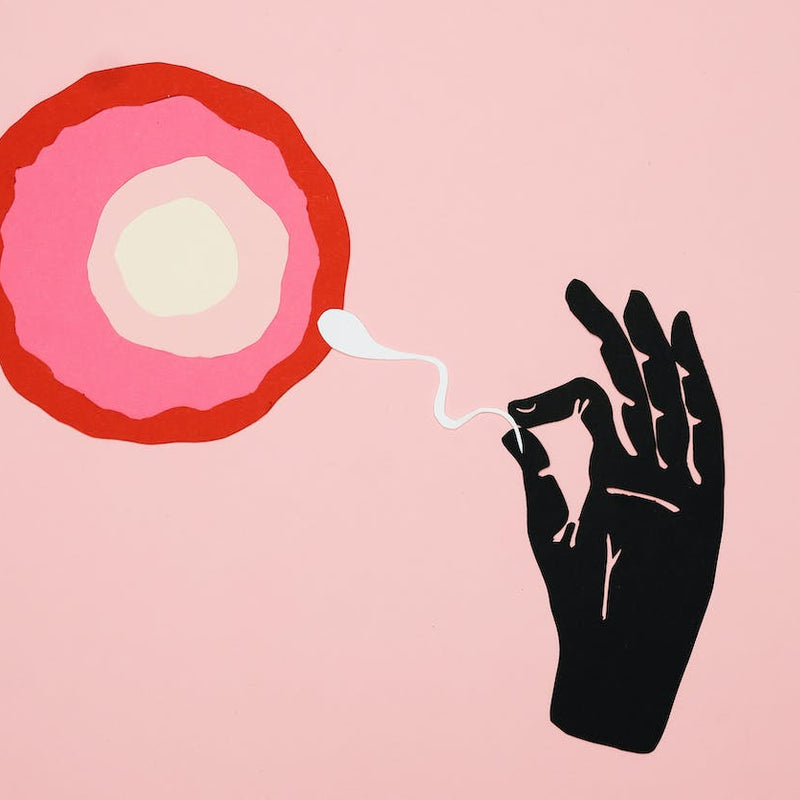How Often Should You Have Sex During Ovulation?

Wondering how often you should have sex when trying to conceive? Read our detailed guide and determine when you are most fertile.
At this point, you’re well acquainted with the basics of heterosexual sex: the man ejaculates, then his sperm swim up through the woman’s vagina and cervix with the hopes of making it all the way to the fallopian tubes. Then, perhaps, one triumphant little sperm unites with an egg. The newly fertilized egg burrows into the uterine wall and develops into an embryo. Nine months later, you’ve got a baby. And that’s that, right? Well, it’s unfortunately not quite that simple, but a little light reading might just help you nail your understanding of exactly what’s going on, so you can time sex to your advantage.
It seems like having lots of unprotected sex should lead straight to pregnancy and a baby. But, for many women, the road to conception is much more complicated.From understanding your cycle and tracking ovulation to sexual health and intercourse, there's a lot that can impact pregnancy. But don’t worry, this guide should be able to help you understand most of it.
Know Your Cycle
Let's begin with the basics of menstruation because you can't time sex if you're not tracking your menstrual cycle accurately (and that's an easy thing to stumble over). The end game here is to figure out your fertile window-the days of the month when you're most likely to conceive, think of it like your peak fertility. After years of suffering through insatiable cravings, painful cramps, and feeling bloated, you can finally appreciate your cycle for its innate purpose: to make a baby.
But the truth is, every cycle can differ. Some may experience “regular periods,” while others notice an “irregular cycle”. It's best to understand how the menstrual cycle works to determine your ovulation.
How the Cycle Generally Works
Cycle length varies from woman to woman, and it does so pretty widely with the normal range being anywhere from 21-34 days and the average duration being about 28-32 days.1,2 Your menstrual cycle is a two-act show: you first have the follicular phase followed by the luteal phase. Day 1, the first day of the follicular phase, is when you get your menstrual period and start bleeding. The odds of getting pregnant on your period are very unlikely. Either way, having sex while ovulating can highly increase your chances.
About midway through your cycle, a hormone in the brain called follicle stimulating hormone (FSH) signals to your ovaries that it’s time to prepare an egg for fertilization. You’re born with a lifetime inventory of eggs— around two million!2 But most of them will never be viable for fertilization, so although this is an awe-inspiring number, it’s not the same as having two million chances to get pregnant. All of your eggs are stored in small, fluid-filled sacs in your ovaries called follicles. Several of these follicles are recruited each month to prepare an egg; however, only one of those follicles will make it to maturity— this follicle promotes its own growth and suppresses the maturation of the other ovarian follicles thus becoming the dominant follicle.2 I bet you didn’t know your ovaries are a battlefield each month, right?
What If There’s a Mature Egg?
For the egg that does mature: this happens around day eight of your cycle when your body's estrogen levels skyrocket. This signals the beginning of your “fertile window”—a six-day period before you ovulate.2
For a couple planning for a pregnancy, experts recommend having frequent sex. Have it daily or every other day during the fertile window, but especially the three days (sperm lifespan) right before you ovulate.3 This is when your chances of conceiving are at their highest. And while it’s definitely still possible to get pregnant in the 1-2 days after ovulation (that’s the egg’s lifespan), the chances of success decline steadily from the day of ovulation onwards.4
A quick rise in luteinizing hormone (LH) is what prompts your ovaries to release an egg every month. This is called the LH surge and usually occurs in the 12-36 hours leading up to ovulation.2
What Happens After Ovulation?
The intrepid egg then ventures down the fallopian tube and into the uterus, where it awaits fertilization by sperm.
Sperm can also be impressively resilient and can survive for up to five days inside the woman’s reproductive tract—that’s why, even though ovulation lasts only about 12-24 hours, the fertile window is usually about six days.3
Lastly, beginning right after ovulation ends, the luteal phase of your menstrual cycle lasts about two weeks for most women. Progesterone and estrogen levels in your body increase. The uterine lining thickens to prepare to support a possible pregnancy.
Although ovulation can get all the attention, your luteal phase is important for conception, too! Some research shows that a shortened luteal phase can make it tougher to conceive.5
If no pregnancy occurs this time around, then the uterine lining sheds, leading to the oh-so-fun process of menstrual bleeding. Then, your regular cycle begins anew.
How Long Does It Take to Get Pregnant After Having Sex?
The actual biological process of conception is pretty miraculous when you think about it, but let’s clear up one misconception: pregnancy does not happen instantaneously—it can often take a few days after sexual intercourse for the egg and sperm to meet up.
Even after these cells unite, the newly fertilized egg must take root in the uterine wall — this is called implantation. This can be a tricky process. Research shows that about two thirds of lost pregnancies happen due to implantation failure.6
Normal implantation can be an asymptomatic process or it can be accompanied by light bleeding (for more information on that, check out our article Is this Spotting My Period or am I Pregnant?).
After the embryo is comfortably situated, certain hormones are released that signal the beginning of your pregnancy. When it comes to testing for pregnancy, a pregnancy test is most accurate when taken up to three days before you expect your regular cycle to start. With our at-home early pregnancy tests, you can test up to five days before your expected period.
Finding the Fertile Window
If you're wondering when to have sex during ovulation, it's important to keep track of your fertile window. Having sex within the fertile window certainly boosts your chances of conceiving, but finding these special few days can be tough, especially for those of us who have irregular periods.
Here are a few simple ways you can figure out your fertile window:
#1 Cervical Mucus
Look out for “fertile-quality” cervical mucus. This is vaginal discharge that is stretchy and translucent and is often compared to egg whites.
To test your cervical mucus, gently insert a (freshly washed) finger into your vagina and try to gauge the consistency and quantity of the discharge. An abundance of egg white-like mucus is a good sign that you’re in your fertile window.
Note, your body is always creating cervical mucus to protect against infections and lubricate during sex. You produce the least amount of mucus right after your period. In general, normal vaginal discharge is yellow or cloudy white and has a sticky texture.
#2 Ovulation Test Kits
Using an ovulation predictor kit or an ovulation calculator can also aid in determining your fertile window. There are many ovulation kits on the market nowadays. Many of them work by measuring LH levels in your urine. As previously mentioned, the LH surge is what prompts your ovaries to release an egg.
Once you see a positive ovulation test—indicating the LH surge has taken place—you can time your sex accordingly.
Of course, an ovulation predictor kit isn’t always accurate for everyone. Conditions like polycystic ovary syndrome (PCOS) can affect LH test results and can also make it harder for you to conceive.
#3 Trackers and Calendars
There are several trackers and calendars available both online and as apps on your phone. We've even put together an Ovulation Tracker and Ovulation Calculator for you here!
#4 Basal Body Temperature
Your basal body temperature (BBT) actually rises a bit after you ovulate, so you can use daily temperature measurements to track your cycle. A woman's BBT generally stays in the range of 97-98 degrees Fahrenheit. After ovulation, the secretion of progesterone by the corpus luteum leads to a rise in the BBT of about 0.5-1 degree Fahrenheit.7
As a result, this can be a useful method but only retrospectively—since the temperature rise occurs after ovulation, you need to record your BBT for several cycles. Some women find it helpful to develop a temperature chart over a few cycles that helps them predict ovulation.
How Much Time to Spend in the Bedroom?
You’re probably wondering if more frequent sex means faster pregnancy, shouldn’t we be doing it as often as possible? At this point though, the science isn’t totally conclusive about how often you should be having sex.8 When you’re having sex seems to be far more important than how often you’re doing the deed.
Although having to pencil sex into your calendar might make it feel just like another household chore, research shows that sex during your fertile window significantly increases your likelihood of getting pregnant.4 Therefore, having fertility awareness should be what really helps you conceive more quickly.
A study published in the New England Journal of Medicine found that nearly all of the pregnancies within their study sample were attributed to sex that occurred during the fertile window. The frequency of intercourse did not make a significant difference .9
Does Sex Position Matter?
There are no specific sex positions that can increase your chances of conceiving. Reclining back with your legs elevated might be a nice relaxation pose, but it won’t do all that much to hurry sperm along unfortunately.
As far as position goes, it’s best to go with whatever you and your partner are most comfortable with. At the end of the day, sex should still be enjoyable for both of you!
What Type of Lubricant Should I Use?
An issue that comes up frequently with couples that are TTC is vaginal dryness. In fact, a survey of 900 TTC couples showed that vaginal dryness was two times higher in these couples than in the general population. The survey also revealed that sexual intimacy was negatively impacted because of this.
Sperm-friendly lubricants (also known as fertility-friendly or TTC lube) are great for couples trying to conceive. Not only do lubricants help reduce friction and make sex more pleasurable, but the right lubricant can make sure that nothing is in the way of sperm meeting the egg.
What About Sperm?
For the men out there, no need to fear - there isn't sound evidence that frequent ejaculation decreases fertility or impacts sperm count. A man's ejaculate has hundreds of millions of sperm and only one of these is necessary for fertilization. If you're at all concerned though and want to save up your swimmers, you can try staying abstinent during the days leading up to the fertile window but not much longer than that-abstinence intervals of five days or more are associated with a drop in sperm counts.4
Although these odds seem good, a man can have a tougher time making a baby if he has low sperm motility or concentration, or if his sperm cells are misshapen. Going back to basics, healthy sperm come from a healthy lifestyle! Eating a nutritious diet, maintaining a healthy weight, cutting down on booze and eliminating cigarettes from your life all promote sperm health. In fact, all of the above is true for women, too. Simple lifestyle improvements can improve your chances of conceiving.
Our Prenatal for Men supplements can also be beneficial in encouraging a healthy lifestyle and body. Learn more about the best foods to increase male fertility.
Conclusion
For the TLDR crowd, what’s the takeaway with all of this? When it comes to sex, timing is key. The research supports having sex daily or every other day during your fertile window, which is the six days preceding ovulation. While there are several ways to detect ovulation, it’s important that you find the most reliable and comfortable method for you.
And as with all things in medicine, you and your partner should make sure to incorporate healthy lifestyle practices as you move forward including decreasing alcohol use, stopping smoking, eating a well-balanced diet, and maintaining a healthy weight. Read our Five Things to Do Before Getting Pregnant article for more!
Sources:
- ACOG Committee on Adolescent Health Care. ACOG Committee Opinion No. 349: Menstruation in Girls and Adolescents: Using the Menstrual Cycle as a Vital Sign. Obstetrics & Gynecology. 2006;108(5):1323-1328. doi:https://doi.org/10.1097/00006250-200611000-00059
- Reed BG, Carr BR. The Normal Menstrual Cycle and the Control of Ovulation. Nih.gov. Published August 5, 2018. https://www.ncbi.nlm.nih.gov/books/NBK279054/
- Wånggren K. REGULATION AND FUNCTION OF THE HUMAN FALLOPIAN TUBE. Semantic Scholar. Published May 11, 2007. https://pdfs.semanticscholar.org/51f3/d90bf911e25fecced17327e4d28be9c855e0.pdf
- Pfeifer S, Butts S, Fossum G, et al. Optimizing natural fertility: a committee opinion. Fertility and Sterility. 2017;107(1):52-58. doi:https://doi.org/10.1016/j.fertnstert.2016.09.029
- Schliep KC, Mumford SL, Hammoud AO, et al. Luteal Phase Deficiency in Regularly Menstruating Women: Prevalence and Overlap in Identification Based on Clinical and Biochemical Diagnostic Criteria. The Journal of Clinical Endocrinology & Metabolism. 2014;99(6):E1007-E1014. doi:https://doi.org/10.1210/jc.2013-3534
- Kim SM, Kim JS. A Review of Mechanisms of Implantation. Development & Reproduction. 2017;21(4):351-359. doi:https://doi.org/10.12717/dr.2017.21.4.351
- Su HW, Yi YC, Wei TY, Chang TC, Cheng CM. Detection of ovulation, a Review of Currently Available Methods. Bioengineering & Translational Medicine. 2017;2(3):238-246. doi:https://doi.org/10.1002/btm2.10058
- Stanford J. Timing intercourse to achieve pregnancy Current evidence. Obstetrics & Gynecology. 2002;100(6):1333-1341. doi:https://doi.org/10.1016/s0029-7844(02)02382-7
- Wilcox AJ, Weinberg CR, Baird DD. Timing of Sexual Intercourse in Relation to Ovulation — Effects on the Probability of Conception, Survival of the Pregnancy, and Sex of the Baby. New England Journal of Medicine. 1995;333(23):1517-1521. doi:https://doi.org/10.1056/nejm199512073332301
Reach Out, We're Here
Have questions about your order or products? For the speediest answer, check out our FAQ section. Need something else? Come find us below.
Please keep in mind our regular business hours; Monday-Friday, 9am-5pm CT.
Customer Support
support@natalist.com
Press Inquiries
media@everlyhealth.com
Business & Partnerships
team@natalist.com
Affiliates + Influencers
team@natalist.com
Job Openings
Careers Page
























